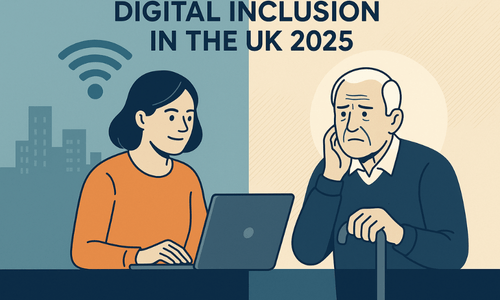Digital Inclusion UK 2025: Closing the Connectivity Gap

Picture this: it’s 2025, the UK is celebrating 86% gigabit coverage, and politicians are calling us a “world leader in connectivity.” But here’s the uncomfortable truth: millions of people are still offline.
That’s right. While some households are streaming in 4K and gaming on ultra-low latency fibre, others are struggling to send an email, pay bills online, or even get connected in the first place. The so-called “digital divide” isn’t closing as fast as you might think; in some ways, it’s widening.
If you’ve ever searched “digital exclusion UK” or “who’s still offline in 2025”, you’ll notice the same story: older adults, rural communities, and low-income households are being left behind. And it’s not just about missing Netflix nights. Lack of digital access impacts healthcare, job opportunities, education, and even basic social connections.
That’s why we created this guide. In the next few minutes, we’ll unpack the latest digital inclusion statistics, reveal who’s still offline and why, explore the barriers that keep people disconnected, and spotlight the policies (and failures) shaping the UK’s digital future.
Because broadband isn’t just about speed, it’s about opportunity. And until everyone is online, we’re not truly a “gigabit nation.”
Who’s Still Offline?
Here’s the shocker: even in 2025, millions of UK residents remain offline or under-connected.
According to the latest Ofcom data, around 3% of UK adults have no internet access at all, that’s roughly 1.7 million people. And if you zoom in by age group, the gap is even starker: nearly 1 in 4 adults aged 75+ either never go online or only use the internet occasionally. For these households, fibre rollout means little if the adoption isn’t there.
Cost is another key factor. Low-income families are disproportionately affected, with social tariffs often underutilised because consumers don’t even know they exist. For older adults, digital skills and confidence can be as much of a barrier as affordability.
This isn’t just about convenience. Lack of access creates a knock-on effect: missed medical appointments, isolation from family, difficulty managing bills, and fewer job opportunities. That’s why broadband for older adults and low-income groups isn’t just a nice-to-have; it’s a lifeline.
We’ve covered this in detail in our senior-focused guides:
- Broadband for Pensioners Made Easy: Your Friendly Beginner’s Guide
- The Advantages of High-Speed Internet for Pensioners
- The Best Broadband Providers for Low-Income Households in the UK (2025 Guide)
Bottom line: despite shiny coverage maps, the UK still has a long way to go in making sure everyone is online. And until those gaps close, the digital divide will keep holding people back.
Barriers to Digital Access
So why are millions of people still offline in 2025? It boils down to three main barriers: cost, skills, and infrastructure.
Cost: Broadband Isn’t Cheap
Even with social tariffs, many households still find broadband unaffordable. Awareness is low, and uptake is far below expectations. For pensioners on fixed incomes, every extra £10–£20 a month makes a difference. That’s why guides like our Affordable Broadband Solutions for Seniors are critical for showing realistic, budget-friendly options.
Skills & Confidence: Fear of the Digital World
For older adults, the barrier isn’t just financial, it’s psychological. Many seniors feel left behind by rapid tech changes, unsure how to set up routers or worried about scams. Our step-by-step Broadband for Pensioners Made Easy tackles this by explaining broadband in simple terms.
Infrastructure Gaps: When Fibre Isn’t There Yet
Despite impressive rollout stats, rural and remote areas are still underserved. Villages can sit just outside a fibre zone, relying on slow copper or expensive satellite solutions. For these communities, Broadband Deals Near Me helps identify the best available stopgaps until fibre finally arrives.
And then there’s the hidden layer: trust. Some people avoid going online due to fears about scams, privacy, or bill shock. That’s why transparent comparisons like our Best Broadband Providers for Low-Income Households matter; they simplify decisions and reduce risk.
Bottom line: the digital divide isn’t just about fibre cables. It’s about affordability, education, and confidence. Until these barriers are broken, “universal gigabit” will remain a slogan, not a reality.
Regional & Demographic Patterns
Here’s the thing: digital exclusion isn’t spread evenly across the UK. It’s patchy, and your chances of being connected depend heavily on where you live and who you are.
Urban vs Rural
Cities like London, Birmingham, and Manchester now enjoy near-universal gigabit coverage. In these areas, digital exclusion is less about infrastructure and more about affordability and awareness. But head into rural Wales, the Scottish Highlands, or isolated coastal towns, and the story changes. Fibre coverage drops dramatically, leaving families reliant on older copper lines or patchy 4G.
If you’re renting or moving often in these areas, flexibility is key. Our guide on Broadband for Renters in the UK: What to Look for in 2025 breaks down how location can affect your choices.
Age & Demographics
Older adults remain the group most likely to be offline. While younger generations treat broadband as essential as electricity, many over-70s still see it as optional or intimidating. That’s why resources like Understanding Broadband for Pensioners: A Simple Guide are vital.
Islands & Remote Communities
Places like Guernsey are fascinating case studies. Once lagging, they’ve accelerated fibre rollout and improved digital participation. We’ve covered this shift in Guernsey’s Fibre Broadband Future and Guernsey Improved Internet.
Bottom line: whether it’s postcode, age, or income, digital access in 2025 is uneven. And until policy and providers tackle these inequalities, the UK’s “gigabit nation” badge will remain only half true.
Trends Over Time
The digital divide isn’t new. But if you zoom out over the past five years, a clear story emerges: COVID was the great accelerator, and the great divider.
During the pandemic, broadband adoption spiked. Seniors who had never video-called suddenly learned Zoom to see their families. Schools scrambled to move classes online, and healthcare providers launched telemedicine appointments almost overnight. Internet use became non-negotiable.
But here’s the catch: while millions adapted, others were left even further behind. Households without reliable broadband, often rural or low-income, struggled to keep up. Children without access to online learning lost ground, and older adults without digital skills became even more isolated.
Fast forward to 2025, and the gap is still visible. Yes, adoption rates have risen, but 1 in 4 older adults remain offline, and thousands of households still cite affordability as the key barrier.
This isn’t just history, it’s a warning. If rapid digital shifts happen again (AI services, telehealth expansion, even government-only online services), those already offline risk falling permanently behind.
We’ve explored some of these challenges in our Social Media Algorithms post, where tech evolution often moves faster than the average user can keep up. For seniors and vulnerable groups, that pace can feel overwhelming.
Bottom line: adoption has improved, but progress is uneven. COVID forced millions online, but unless affordability and education catch up, the same groups will keep missing out on the benefits of a digital-first world.
Policy & Inclusion Efforts
So what’s actually being done to close the gap? On paper, the UK has a roadmap. In practice, progress is uneven.
Government Targets
The headline goal: 96% full-fibre coverage by 2030. That’s ambitious, and backed by billions in investment. But coverage is not the same as inclusion. Unless affordability and digital skills are tackled alongside rollout, “coverage” risks becoming an empty statistic.
Ofcom’s Role
Regulation has sharpened. Ofcom now requires greater transparency in broadband pricing and service quality. That means clearer contracts and fewer hidden fees. But as our coverage on Ofcom’s Broadband & Mobile Prices shows, rising bills remain a sticking point for low-income households.
Meanwhile, Ofcom’s latest rulings, detailed in our guide on New Telecoms Rules & Market Implications, are designed to encourage competition and protect consumers. The question is whether smaller players and alt-nets can maintain momentum without being squeezed out.
Funding & Social Tariffs
The government has promoted social tariffs, discounted broadband for low-income families and pensioners. But uptake remains frustratingly low. Many households don’t know these offers exist, and providers aren’t doing enough to promote them.
Local & Community Initiatives
Some of the most promising progress is happening outside Westminster. Local councils and community groups are piloting free digital training sessions, device lending schemes, and local broadband projects. These grassroots efforts often achieve what national policy misses: building trust and skills alongside connectivity.
Bottom line: policy is moving, but not fast enough. Without stronger enforcement and better promotion of affordability schemes, digital exclusion will remain baked into the system.
Practical Solutions: What Works
Community Training & Digital Skills
The good news? Digital exclusion isn’t a dead end. Across the UK, real-world solutions are proving that the divide can be closed when affordability, skills, and trust are tackled together.
Local libraries, councils, and charities are running free workshops to help seniors build confidence online, from sending emails to using video calls. These initiatives show that skills matter as much as fibre rollout. For a personal starting point, our Beginner’s Guide to Broadband for Pensioners walks through the basics step by step.
Device & Equipment Access
Some community schemes are lending laptops or tablets to households that can’t afford them. Without a device, broadband is pointless, and this simple intervention removes a critical barrier. Families supporting older relatives can also benefit from our Choosing Internet for Elderly Parents: A Step-by-Step Guide.
Affordable Plans & Awareness
Social tariffs and flexible contracts are game changers when promoted properly. Pensioners and low-income households don’t have to settle for overpriced, long-term deals. Our Affordable Broadband Solutions for Seniors and Best Broadband Providers for Low-Income Households highlight the offers that really save money.
Bottom line: progress is possible when infrastructure meets education, trust, and affordability. With the right mix of policies and grassroots solutions, digital inclusion can shift from ambition to reality.
Conclusion
Here’s the bottom line: the UK is racing ahead on gigabit rollout, but progress means nothing if millions remain offline. Digital inclusion isn’t about cables in the ground; it’s about people. Seniors, rural households, and low-income families deserve the same access to opportunity, education, and connection as everyone else.
The divide can be closed. With affordable plans, better awareness, and a little digital confidence, nobody has to be left behind.
>>Start by exploring our Compare Broadband Providers in the UK.
>>Check out the latest Broadband Comparison tools to see what fits your household best.
Because broadband isn’t just about faster streaming. It’s about inclusion, fairness, and giving every home, from city flats to rural cottages, the chance to thrive in a connected world.
Your digital future starts now. Don’t get left offline.



